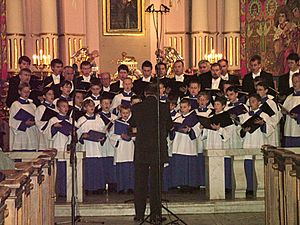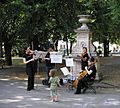Classical music facts for kids
Classical music is a type of music that comes from Western countries. It's usually written down by musicians who are trained in composing. This means other musicians can play it exactly as the composer intended. You might also hear it called "art music." Unlike pop music, classical music isn't made just to be popular or to sell a lot. It's also different from folk music, which is often learned by listening and copying, not by reading sheet music.
Contents
What's the Difference: Classical, Pop, and Jazz?
Even though some people think classical music is the opposite of pop music, it can still be very popular! Classical music can make you feel many different things: happy, sad, peaceful, or even excited. For example, Mozart wrote fun pieces called serenades and divertimentos for parties.
Classical music pieces can be short, but many are long, like a big musical story. A symphony by Mahler or Shostakovich can last almost an hour. An opera can even be a whole evening's entertainment!
Classical music is also different from jazz because jazz often involves musicians making up music on the spot (this is called improvisation). However, the lines between them aren't always clear. Jazz has inspired classical music, and classical music has inspired jazz. George Gershwin wrote music that mixes both styles. Even famous classical composers like Bach, Mozart, and Beethoven often improvised long pieces on the organ or piano. Sometimes, they wrote these down later.
Music for Church and Other Places
For a long time, a lot of music in Western countries was written for Christian church services. This is called "sacred" (religious) music. All other music is called "secular" music, meaning it's not religious.
Sacred and secular music have influenced each other a lot throughout history. For example, secular music was often influenced by dance rhythms. This then changed the style of sacred music. The church music of Giovanni da Palestrina in the 1500s didn't use dance rhythms. But two centuries later, both the sacred and secular music of Johann Sebastian Bach were full of them!
When composers wanted to try new ways of writing music, they often started with secular music. Sacred music would then catch up later.
What Does "Classical Music" Mean?
The term "classical music" wasn't really used until the early 1800s. People started using it to praise great composers like Bach, Mozart, and Beethoven.
In the 1900s, composers tried many new ways of writing music. This included music played by electronic instruments or very modern music with unusual sounds. Some people feel that this kind of music, like that by John Cage, isn't really "classical music."
Instruments in Classical Music
Classical music can be played by instruments or sung by singers. The symphony orchestra is the most common group of instruments for classical music. It has four main groups:
- String instruments: These include violins, violas, cellos, and double basses.
- Woodwind instruments: Such as flutes, oboes, clarinets, and bassoons.
- Brass instruments: Like trumpets, trombones, tubas, and French horns.
- Percussion instruments: These usually include timpani (kettledrums) and many other instruments that are hit or shaken.
This is very different from a typical rock band, which usually has a drummer, guitarist, singers, and electric bass and keyboard. Instruments in classical music are usually not made louder electronically (they are not amplified).
The same goes for singers. Their voices are not amplified. Opera singers, for example, train to have very powerful voices. They need to be heard clearly over the orchestra, even at the very back of a large opera house.
Classical instruments developed over a long time. Some, like the trombone and triangle, haven't changed much for hundreds of years. The violin family grew from folk instruments like fiddles. They slowly replaced older instruments called viols to become the main part of the modern orchestra by the 1600s. This was also when opera was invented!
Generally, musical instruments have become louder as concert halls have grown bigger. Modern violins are louder than early ones, partly because they now use metal strings instead of animal gut strings. The piano developed from quieter instruments like the clavichord. The clarinet was invented in the mid-1700s, and the saxophone and tuba came even later.
How Classical Music Pieces Are Shaped
Most popular music follows a "song form." But classical music uses many different "forms" or shapes. These forms can be used to create very long and complex pieces.
Classical music can take many forms, such as the symphony, concerto, oratorio, opera, sonata, or fugue. It can also be a mix of dance pieces, like a suite. In many longer pieces, short tunes are developed and changed throughout the music. Beethoven’s Fifth Symphony is a great example. It starts with just four notes and grows into a large piece that lasts about half an hour.
Learning and Using Classical Music
People who want to play classical music well need to practice very hard for many years. They often go to a music college or conservatoire. There, they learn from famous music teachers.
Classical musicians often spend a lot of time studying music carefully. They learn about things like harmony and counterpoint. This helps them understand how composers thought when they created the music. This study is called "musical analysis." People who specialize in this might become professors at universities.
Classical music is often heard in everyday life. It's used as background music in movies, television shows, advertisements, and even as mobile phone ringtones. Many people in Western countries recognize classical tunes without even knowing what they are! Some classical pieces have become hugely popular. For example, the song Nessun dorma from Giacomo Puccini's opera Turandot was sung by the Three Tenors (Luciano Pavarotti, Plácido Domingo, and José Carreras). It was even used as the theme song for the 1990 Soccer World Cup. This made many people interested in opera for the first time.
A Quick Look at Classical Music History
Middle Ages
The history of classical music really began in the late Middle Ages. Most music written for the church was sung, because instruments were sometimes seen as wrong. This was because they were linked to the devil or used for dancing. There was a lot of dance music, but most of it is lost because it wasn't written down.
Important composers from this time include Léonin, Pérotin, and Guillaume de Machaut.
Renaissance
The Renaissance period lasted from the 1400s to the 1600s. During this time, a huge amount of music was composed, both sacred and secular. Many grand cathedrals were built in Europe, and composers wrote mostly vocal music for them. Secular music also became very popular, especially songs and madrigals. These were sometimes played with instruments.
Some of the greatest composers of this period are Giovanni da Palestrina, Orlando di Lasso, Thomas Tallis, and William Byrd.
Baroque Period
The Baroque period was from about the 1600s to the mid-1700s. This was when the modern orchestra started to take shape. It was also the time when opera was invented. Most musicians worked for churches or for rich people who had their own orchestras. Many also started working for opera houses.
Key composers from this time include Claudio Monteverdi, Heinrich Schütz, Henry Purcell, Antonio Vivaldi, George Frideric Handel, Johann Sebastian Bach, Domenico Scarlatti, and Georg Philipp Telemann.
Classical Period
The years between 1760 and 1825 are known as the Classical period. Composers focused a lot on the forms of their pieces. They were inspired by the art of Ancient Greece and Rome. The symphony was invented, along with different types of chamber music, like the string quartet.
The greatest composers include Joseph Haydn, Wolfgang Amadeus Mozart, Christoph Willibald Gluck, and Ludwig van Beethoven.
Romantic Period
From 1820 to 1910 was the Romantic period. Composers still used the forms from the 1700s, but they also believed that personal feelings and emotions were very important. Orchestra music sometimes told a story (this is called programme music). Musicians who played their instruments amazingly well, like Paganini, were seen as heroes.
Beethoven and Schubert belong to both the Classical and Romantic periods in many ways. This was a time of big changes in society. There was a strong feeling of nationalism as countries united. So, 19th-century music often sounded very typical of its own country.
Some of the greatest composers include Ludwig van Beethoven, Franz Schubert, Hector Berlioz, Frédéric Chopin, Robert Schumann, Felix Mendelssohn, Anton Bruckner, Johannes Brahms, Pyotr Ilyich Tchaikovsky, Edward Elgar, Gustav Mahler, and Richard Strauss.
20th Century
What we call 20th-century classical music (or "modern music") is from about 1910 onwards. Many composers felt that everything had already been done by past composers. So, they wanted to find new ways to write music. Claude Debussy, Arnold Schoenberg, and Igor Stravinsky found new ways to write music that wasn't always in a specific key. Classical music was also influenced by jazz, especially by American composers.
Later in the century, people like Pierre Boulez and Karlheinz Stockhausen experimented in many other ways. This included using electronic music (like tape recorders). Today's composers have mixed some of these ideas to create their own unique styles.
Some of the most important composers are Claude Debussy, Jean Sibelius, Maurice Ravel, Arnold Schoenberg, Igor Stravinsky, Béla Bartók, Aaron Copland, Benjamin Britten, Dmitri Shostakovich, Leonard Bernstein, Philip Glass, Dmitri Kabalevsky, James MacMillan, Judith Weir, and Peter Maxwell Davies.
Conclusion
It's always been hard to say exactly what "classical music" means. Many different kinds of music influence each other. Since the 1970s, it's become even harder to draw clear lines between rock, pop, classical, folk, jazz, and world music. This shows that classical music, like all music, keeps changing and reflects the world it comes from.
Images for kids
-
A string quartet performing for the Mozart Year 2006 in Vienna.
-
A musician playing the vielle, an instrument from the 1300s.
-
An old, decorated music book called the Chigi codex, showing music by Johannes Ockeghem.
-
Baroque instruments like the hurdy-gurdy, harpsichord, bass viol, lute, violin, and baroque guitar.
-
Joseph Haydn (1732–1809) in a painting from 1791.
-
Josef Danhauser's 1840 painting of Franz Liszt at the piano, surrounded by other famous people of his time.
-
Igor Stravinsky, drawn by Pablo Picasso, who worked together on a ballet called Pulcinella in 1920.
-
The famous pianist Martha Argerich performing in Buenos Aires.
See also
 In Spanish: M%C3%BAsica cl%C3%A1sica para ni%C3%B1os
In Spanish: M%C3%BAsica cl%C3%A1sica para ni%C3%B1os













